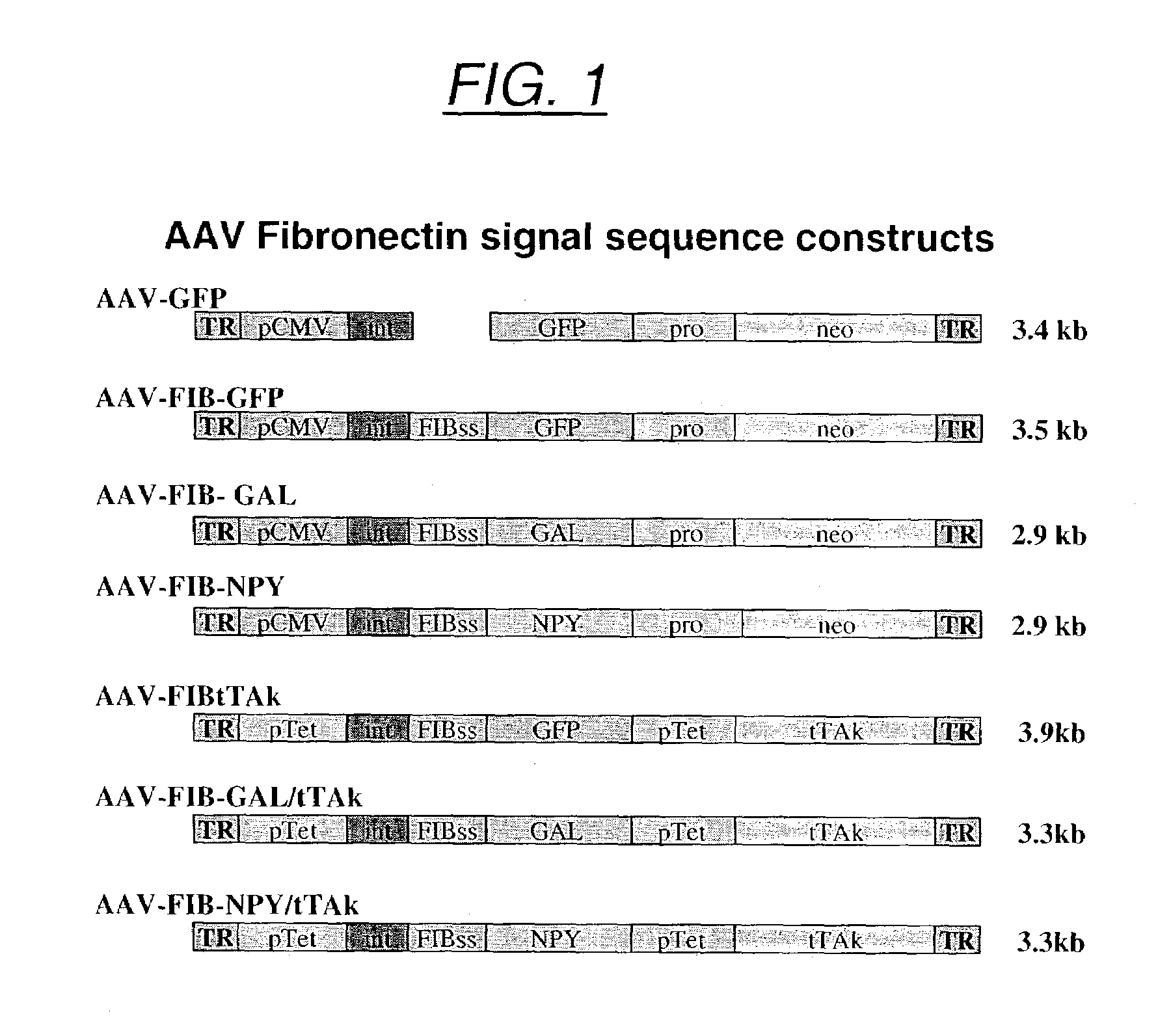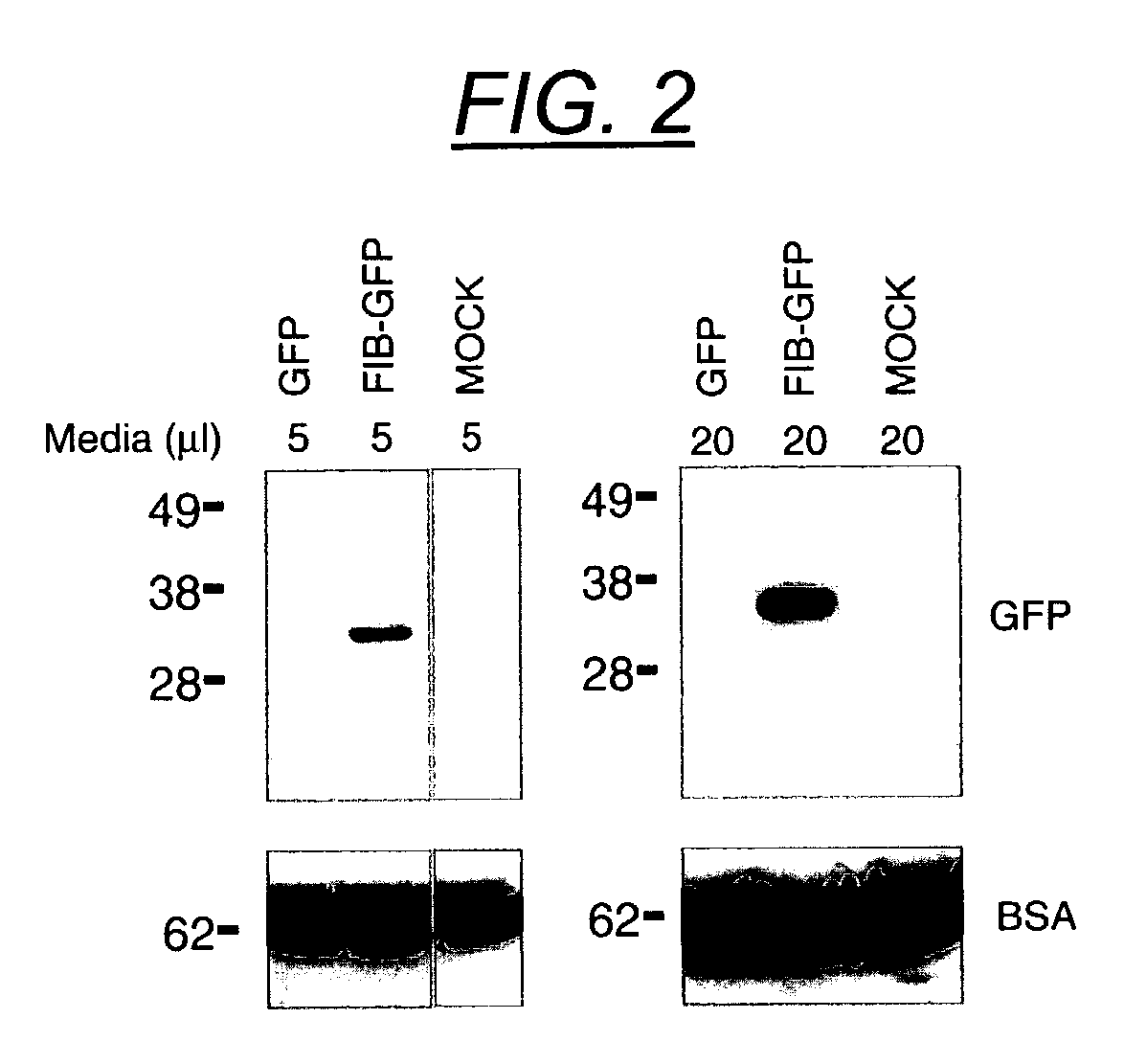Secretion signal vectors
- Summary
- Abstract
- Description
- Claims
- Application Information
AI Technical Summary
Benefits of technology
Problems solved by technology
Method used
Image
Examples
example 1
GFP and GAL AAV Plasmid Constructs
[0223]The fibronectin signal sequence (FIB, nucleotides 208–303, 5′-ATG CTC AGG GGT CCG GGA CCC GGG CGG CTG CTG CTG CTA GCA GTC CTG TGC CTG GGG ACA TCG GTG CGC TGC ACC GAA ACC GGG AAG AGC AAG AGG-3′, SEQ ID NO:1) was derived from the rat fibronectin mRNA sequence (Genbank accession #X15906) and codes for the following peptide signal sequence:
[0224]
(SEQ ID NO:2)Met Leu Arg Gly Pro Gly Pro Gly Arg Leu Leu LeuLeu Ala Val Leu Cys Leu Gly Thr Ser Val Arg CysThr Glu Thr Gly Lys Ser Lys Arg
[0225]Oligonucleotides corresponding to both strands were generated (Midland Certified reagent company, Midland, Tex.). The oligonucleotides containing the fibronectin signal sequence were:
[0226]
FIbSS A:5′-CCG GTA TGC TCA GGG GTC CGG GAC CCG GGC GGC(SEQ ID NO:7)TGC TGC TGC TAG CAG TCC TGT GCC TGG GGA CAT CGGTGC GCT GCA CCG AAA CCG GGA AGA GCA AGA GG-3′ andFibSS B:5′-CCG GCC TCT TGC TCT TCC CGG TTT CGG TGC AGC GCA(SEQ ID NO:8)CCG ATG TCC CCA GGC ACA GGA CTG CTA GCA GCA GC...
example 2
Virus Production and Purification
[0230]Recombinant AAV was produced as previously described (Haberman et al. (2002) Mol. Ther. 6:495, Xiao et al. (1998) J. Virol. 72:2224) within the UNC vector core. Briefly, HEK 293 cells were transfected with the transgene plasmid, pACG2 and XX6-80 via the calcium phosphate method. Cells were lysed by freeze thaw or deoxycholate, and cell lysates were centrifuged through a discontinuous iodixanol gradient. The virus was further purified over a Hi-trap heparin column (Amersham Pharmacia Biotech, Piscataway, N.J.), dialyzed into phosphate-buffered saline / 5% sorbitol and stored at −80° C. until use. Recombinant virus titers were calculated by dot blot (Haberman et al. (1998) Gene Therapy 5:1604) and were as follows FIB-GAL: 2.3×1010 particles / ml (AAV-FIB-GAL / tTAk, FIG. 1), GAL: 1.2×1012 particles / ml (AAV-GAL-tTAk), FIB-GFP: 1×1012 particles / ml (AAV-FIBtTAk, FIG. 1) as determined by dot blot.
example 3
Transfection and Cell Lysates
[0231]HEK 293 cells were maintained in DMEM supplemented with 10% FBS and penicillin / streptomycin. Cells were plated into 6 well plates and transfected 24 hours later using Superfect (Qiagen, Valencia, Calif.) or Lipofectamine 2000 (Invitrogen, Carlsbad, Calif.) according to manufacturers directions. Cells were transfected with plasmids containing GFP alone, FIB-GFP or mock transfected. At 24 hours, GFP positive cells were counted and found to be equivalent in GFP as compared to FIB-GFP. Mock cells showed no GFP fluorescence. The media was then removed and cells were incubated. The media was removed 24 hours post transfection, and cells were incubated in lysis buffer (50 mM Tris, pH 8.0, 150 mM NaCl, 50 mM NaF and 1% NP-40) for 30 min at 4° C. with gentle rocking. Lysates were centrifuged for 5 min and the supernatant was removed to a fresh tube. Both media and cell lysates were stored at −80° C. until use. To obtain extracts for the galanin ELISA, plasm...
PUM
| Property | Measurement | Unit |
|---|---|---|
| Pharmaceutically acceptable | aaaaa | aaaaa |
Abstract
Description
Claims
Application Information
 Login to View More
Login to View More - R&D
- Intellectual Property
- Life Sciences
- Materials
- Tech Scout
- Unparalleled Data Quality
- Higher Quality Content
- 60% Fewer Hallucinations
Browse by: Latest US Patents, China's latest patents, Technical Efficacy Thesaurus, Application Domain, Technology Topic, Popular Technical Reports.
© 2025 PatSnap. All rights reserved.Legal|Privacy policy|Modern Slavery Act Transparency Statement|Sitemap|About US| Contact US: help@patsnap.com



